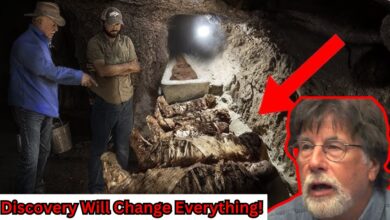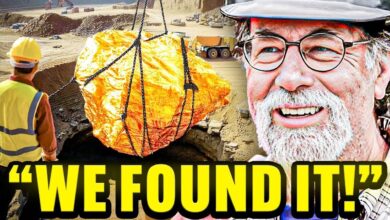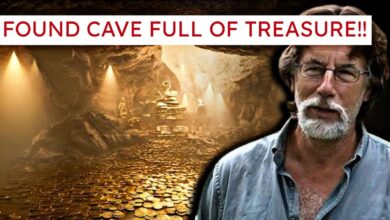Oak Island’s Most Mysterious Ancient Structures Exposed | The Curse of Oak Island
Oak Island’s Most Mysterious Ancient Structures Exposed | The Curse of Oak Island

[narrator] A circular stone depression… Thirteen feet.
That is the exact same dimension -as the money pit. -[chuckles]
[narrator] …containing important clues and possible valuables.
[Marty] Wow. Stand right there and you’ll get a real good perspective.
[narrator] A cobblestone road matching a 2,000-year-old construct located halfway around the world.
[man 1] If there is a Portuguese connection to the construction of the road in the swamp, maybe this is the blueprint.
[narrator] And a wooden shaft…
[Drayton] Oh! That’s the best sounding target.
-[Marty] Really?
-[Drayton] Yep.
[narrator] …that just might reveal the Oak Island mystery’s ultimate answers.
[Drayton] Well, where there’s muck, there’s treasure, mate.
-[laughs]
-[Marty] Treasure island, baby.
In just a few short weeks, Rick and Marty Lagina, along with their team, will be back for the mind-blowing season 11 premiere of The Curse of Oak Island.
And while the money pit remains a top priority in their quest to unearth a legendary treasure…
-Oh. We got wood.
-Whoa! It looks like it might be a new shaft.
It changes the whole story.
We could be looking at the money pit.
[dramatic music playing]
[narrator] …they’ll also be investigating numerous structures of unknown origin they’ve discovered all across the island.
Well, this construct is unique to the island.
[Niven] This is quite something.
So tonight, we’re digging into the most perplexing, man-made structures the team has found that suggest this mystery is more complex and goes further back in time than anyone ever knew.
Is the Fellowship of the Dig on course to unearth multiple treasures?
[narrator] Number three, the well on lot 26.
-Wouldn’t know it was a well.
-Yep.
-Looks crudely made.
-It does.
[narrator] In 2022, Rick Lagina prompted Laird Niven and Dr. Spooner to conduct water tests and take core samples from this structure on lot 26 which is located less than 100 feet from the believed 16th-century stone wall.
From the moment I saw the well in the wintertime years ago, it wasn’t frozen. That was the real, “A-ha, why is this well so unique?”
[Spooner] Let’s just see how we did. Oh, quite good. Excellent. There we go. That’s a pretty good core.
[narrator] The first major clue that the well might be directly connected to the Oak Island mystery came from the water testing Dr. Spooner performed.
So we got samples of the water from the well. And, uh, it was one of our only silver hits outside of the money pit.
Well done.
[narrator] As the team worked to determine how old the well might be, Laird led the effort to excavate the feature, revealing it to be much larger and more intriguing than first thought.
[Marty] The well is really quite amazing. In the context of other things found on lot 26, it maybe, uh, moves the dial upwards and we’re trying to figure out how old it is. Because lot 26 has always been mysterious.
[narrator] And while the source of the silver detected in the well remains a mystery for the time being…
I’ll turn it over to Dr. Spooner and let him describe the core and then the results.
[narrator] …when the carbon dating of the organic materials found inside it were complete, it proved that the well may be the oldest structure ever found on Oak Island.
[Spooner] The date I got on the twig at the bottom was, um, 1028 to 1172.
-[whistles]
-This is brilliant.
-[Spooner] Yeah.
-Great.
The dates… It blew me away. I mean, what’s this doing in this core?
-Yeah.
-That is really cool.
If that well is that old, you gotta really think about what happened on this island.
Yeah, exactly. Like Templars were here or something.
There you go, Jack. You gotta wonder what the story is.
Templars, baby!
[laughter]
[narrator] Number two, the circular stone depression.
[Alex] Here it is. All right, here we be.
-[Niven] Yeah.
-What is this, Laird?
I thought it was something like the cellar for a barn.
-Oh.
-Hm.
-Almost perfectly circular.
-[Niven] I know.
[narrator] In 2022, the Laginas and Craig Tester purchased lot 5 which is located on the western side of the island.
All they really knew about it was that it previously belonged to the late treasure hunter Robert Young, and that he had reportedly made a number of historic discoveries there including ancient coins and artifacts.
We’ll just add to Robert’s legacy.
[Niven] Mm-hm. That’s the whole point. Continuing the work that he did for many, many, many years.
The lot is a mystery.
-Let’s see what we can find.
-Okay.
[narrator] And continue Robert’s work they surely did with incredible discoveries such as a stone foundation believed to date to the 1730s, a 2,000-year-old Roman coin, and a lead barter token that might not only be related to the 14th-century lead cross but also the Knights Templar.
Let’s start by probing, like, here.
Yep. And that should be surface.
-That is a rock.
-Then go the other way.
[dramatic music playing]
So confidently, I can say there’s rocks here.
Yep. And you can see rocks here.
It’s circular. I mean, you can even see it. You know, from the trowel to this little tree.
[narrator] So when they began investigating the circular depression on lot 5 that was completely lined with rocks…
-That’s soil.
-Soil.
[narrator] …they were stunned by what they were able to determine.
-I think, uh…
-Why don’t we measure it?
-Sure.
[dramatic music playing]
See if it conforms to some sort of standard.
-You’re lined up with the edge?
-Yeah.
Here, we’re at 13 feet.
That’s a bizarre measurement. That is the exact same dimension as the money pit is described as having.
Yeah. [chuckles]
I mean, what are we lookin’ at here? [laughs]
[narrator] The structure matched the original description of the money pit when it was found in 1795.
A circular depression lined with paving stones with a 13-foot diameter.
[Marty] The round feature on lot 5 can turn out to be significant because it’s so odd. It’s a thing not found elsewhere on Nova Scotia on Oak Island. It could be very meaningful. We need to explore it.
You can see rocks coming up here, so well below these placed rocks.
-[Begley] Yeah. Yeah.
-Right?
The occupation could be… I mean, we’re finding artifacts from the 1750s.
Wow. Is there any chance the top feature was built at a later date than the rocks that are lower?
Absolutely. Yeah, this was at a later date.
Yeah, and there could be an even earlier component under that.
-Oh.
-Right?
So this could be a really old stone feature that was then rebuilt and… and rock-lined back in the 1700s.
[Niven] That’s what we’re hoping for.
[narrator] Finding pottery that dated to the mid-1700s convinced Laird Niven that the feature must predate the discovery of the money pit.
But as the team continued to reveal more layers of stone, it made them wonder if this structure was something they’ve been trying to locate for several years.
Sounds to me like the top feature is not just an apron. It’s the limits of quite a massive structure.
Yeah. It could go deeper.
This could fit in with Zena’s map.
This could be the hatch.
It’s close to the proximate location that we’re looking for the hatch.
[narrator] Ever since the late author and researcher Zena Halpern gave the team a reported 14th-century map of Oak Island that she believed had been created by members of the Knights Templar, they have been looking for features labeled on it.
And one that has especially interested them is marked right in the vicinity of lot 5 called “The Hole Under the Hatch.”
I believe in Zena Halpern’s work. I believe that the map represents some features on the island.
Um, is it possible that this might be the hatch?
There are a lot of possibilities on this island.
Who knows what we might find down at the bottom of that and where it might lead to?
[narrator] Number one, the garden shaft.
Okay, that would probably be the outside wall there.
Ten-four.
[Niven] Ten by ten shaft.
[narrator] When the team first uncovered the 82-foot-deep assumed searcher shaft, Rick thought it should be preserved for posterity.
So he and Billy Gerhardt built a rock garden around it as a tribute to all the women involved with the 228-year-old search.
[Spooner] We’ve sampled wells within the money pit area and we do have some chemistry back from this.
We did do a series of measurements of water levels near the garden shaft, uh, heading south.
[narrator] But then, in 2022, geoscientist Dr. Ian Spooner and hydrogeologist Dr. Fred Michel tested water in the shaft as well as in surrounding bore holes during their ongoing effort to pinpoint the location of the money pit treasure vault.
We scooped up two samples in the garden shaft sent those away.
We found, uh, gold in the garden shaft.
[laughter]
[narrator] If those gold results weren’t enough, when carbon dating on a wood sample suggested that the garden shaft was more than half a century older than the discovery of the money pit in 1795, Rick, Marty, and Craig commissioned Dumas Contracting Ltd., a mining company, to rebuild the structure so they could investigate for more clues and valuables.
Emma’s got some news.
So you guys gave me these.
-Right.
-This piece right here, ’cause it’s small, I could do a…
-map scan of it in a short–
-What is that?
[Emma] That’s the garden shaft inner lining that…
-Okay.
-The wood pieces.
-The original shaft.
-Yeah.
[narrator] As the reconstruction continued, the team had archaeometallurgist Emma Culligan test a wood sample taken from a depth of 50 feet.
And from this one… I detected… gold.
-Wow.
-[narrator] Those results made the team suspect that the garden shaft could be related in some way to the money pit.
Especially when they discovered a nearby tunnel some 95 feet deep where water sampling showed the highest traces of gold running almost directly below the shaft.
[Drayton] Hello, mate. Coming down.
What do you think, Gary?
-Oh-ho-ho. Wow. What a ride.
-Huh?
[laughter]
Oh my God. This is fantastic.
[narrator] Although nothing was found once Dumas finished the shaft down to the bottom at 82 feet, before they had to suspend the hunt for winter, Rick and Marty just had to ask metal detection expert Gary Drayton to scan below it for any signs of where the gold was coming from.
-[Rick] It’s two feet deep.
-[Drayton] Okay.
Well, where there’s muck, there’s treasure, mate.
We’ll see what’s down there, mate.
All right. Extend it a little bit.
[tense music playing]
Right.
[music intensifies]
[detector beeping]
Oh! That’s the best sounding target.
That’s a non-ferrous, yeah.
-[Marty] Really?
-[Drayton] Yep.
[Rick] I mean, that’s a screaming large hit, isn’t it?
[Drayton] Yeah. That sounded really good.
[Rick] I’ve said it before. Oak Island is an island of “what ifs” and possibilities.
But I want more than that. We all want more than that.
I think we all sincerely believe that we have boxed it in to the point where we will solve it.








